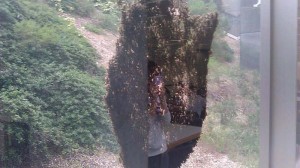A lot of nurseries around here tout plants as being hummingbird- or butterfly-friendly. Those little critters are awfully decorative and fun to have around, but the major work of pollination belongs to the bees. For instance the California almond crop supplies something like 80% of the world’s almond exports, and the crop wouldn’t be possible without all the hives that are trucked into the Central Valley about this time of year. According to the Los Angeles Times, farmers now are spending more on renting hives than they are on watering their trees.
A recent article, The Headbonker’s Ball, in Orion Magazine has a great article on the Urban Bee Project, a project headed by UC Berkeley prof Gordon Frankie that’s designed to educate folks about the value of having bee-friendly gardens. Their Urban Bee Gardens site crawls with all sorts of information on the value of bees and what you can do to welcome them into your garden. Some of it’s under construction still, but there’s already lots of useful information there.
One of the cores of the site is a list of plants that are friendly to bees, and the list is broken into spring plants and summer plants so that you can plan a progression of food sources for the little guys. The list is a little Berkeley-centric, though many of the plants on the list would grow plenty of other places. At first you might worry that you’d have to plant oddball ugly plants just to the do the right thing, but incorporating bee-friendly plants requires no such thing. A lot of the selections are really common garden plants, and you probably have a number of them in your garden already: lavenders, penstemons, salvias, cosmos, sunflowers, and the like.
With all the plants out there the list couldn’t possibly list every bee-friendly plant out there.Various thymes, for instance, have a reputation for being major bee party pads. The Berkeley project came to its conclusions by sending people out into gardens and having them count how many bees visited a plant in a certain time period. (Not a bad way to conduct research, eh?) You could do the same. If there’s something not on the list but you notice that the bees like it, why not plant a little more of it? Give the hummingbirds and butterflies some company.










